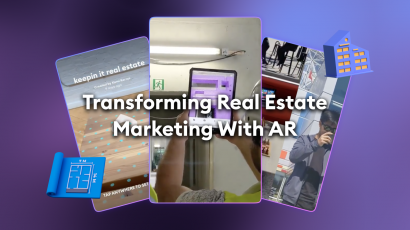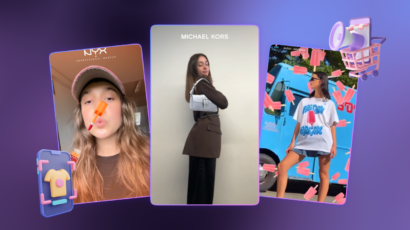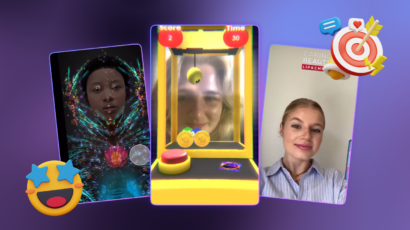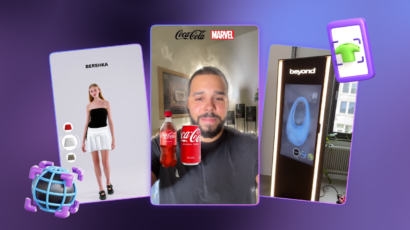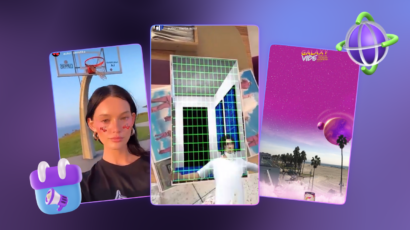Numerous online experiences have been significantly improved by Augmented Reality (AR). Since AR has the potential to increase brand visibility and improve the customer experience, many sectors have begun to adopt this technology.
AR is a technological advancement that allows users to interact with digital content in the real world. AR removes the need for in-person visits by enabling prospective purchasers to explore properties from anywhere and experience virtual walkthroughs. According to a 2019 study by Deloitte half of commercial real estate investors feel the industry should prioritize the integration of AR. And they are absolutely right!
Eliminating The Difficulty Of Visualizing Properties With AR
According to a survey, 85% of home buyers use smartphones to look for homes, while 54% use the internet as the first step in the home-buying process.
Potential purchasers can engage with and fully immerse themselves in an AR experience, visualize the style, layout, and characteristics of a house before making a choice. By using virtual staging, furniture arrangement, and color selections, AR can present accurate depictions of homes, reducing the chance that purchasers may be let down by false property descriptions.
How a WebAR Solution Solved Several Issues in Real Estate Marketing

The real estate industry often faces the problem of helping buyers visualize their future homes and thereby convincing them to purchase. AR can address this problem with webAR.
In order to assist homeowners in giving the exterior of their homes a modern and fresh appearance, James Hardie, a leading provider of superior building solutions, introduced the webAR based – Hardie Architectural Collection.
The outcome was an interactive booth experience that allowed visitors to customize one of three model homes by utilizing the power of AR. Visitors could start the experience on their own mobile devices by scanning a QR code, then with the help of AR, proceed to a design podium in the booth to build the house of their dreams.
The Hardie Architectural Collection’s limitless design options were on display in the AR trade show experience, which let consumers customize their AR homes in over 20,000 different ways to suit their individual preferences. Once done, users could share a screenshot of their choices and, at their discretion, submit a brief form to be contacted by the James Hardie team.
This is an excellent example of how the brand can solve several objectives with AR solutions. They created memorable and significant experiences for their potential buyers, increasing brand loyalty. Moreover, this experience served to boost sales.
Immersive technology like AR can provide a variety of alternatives for marketers looking to add a new level of interactivity to their trade fair experiences.
Revolutionizing Efficiency: Redefined Costs and Time
Building physical models can be an expensive and time consuming task. With augmented reality, real estate companies can produce virtual experiences at a fraction of the cost. With AR product visualization users can view their product virtually before it is constructed in a physical space.
By giving prospective buyers additional details about the property in a more efficient and interesting way, AR can speed up the sales process and encourage quicker decision-making.
For prospective consumers, AR can offer individualized and tailored experiences that let them visualize and select how furniture or other accessories will look in a particular space.
To provide an immersive experience in a real-world setting, AI Interior Designer makes use of both the centimeter-level accuracy of VPS and the almost endless creative potential of the Stable Diffusion Material Algorithm, which generates seamless textures. The combination of AR and AI technologies enables us to create highly realistic 3D environments that can be experienced in real life.
By providing a seamless and realistic experience for both parties, AI Interior Designer creates the ideal selling environment where buyers can visualize themselves in a space with little effort on their part. This is an advantage not only for sellers but also for buyers, who don’t have to spend time searching for furniture or making decisions about flooring or paint colors.
Increasing Brand Awareness and Customer Engagement With AR
Prospective buyers are unable to observe or lack information about the business and its ambitions. The easiest approach to reach the correct audience and inform them about the firm is through social media campaigns such as facial filters, and mini-games. In this instance, AR can be utilized to raise awareness and engage customers in brand essence.
Jabal Omar, one of the biggest development firms in Saudi Arabia with its headquarters in Makkah, created an AR filter to increase brand recognition and establish a connection with their target market by evoking the spirit of the holy city and encapsulating its culture. The filter allows users to capture their surroundings in Makkah and share them with friends on social media. Enabling users to interact with the branded content leads to brand loyalty and increased customer engagement, as well as brand awareness.
Since implementing AR on social media is a well-known and practiced marketing tool, an Australian private corporation Hilti, which manufactures fastening tools and related goods created an AR mini-game to promote their products. The game is a simple, yet entertaining way to engage their audience.
Wrapping it Up: Key Takeaways
Buying a home is an extremely personal and emotional decision. Adding an augmented reality component to the home buying process takes the buyer on a personal trip.
AR is the future. The technology’s revolutionary visualization and interaction capabilities have proven too powerful to ignore. It’s apparent that augmented reality can solve the main marketing pain points of the sector. Furthermore, it has the potential to transform the real estate industry, and the buying and selling process. Embracing AR technology can help realtors differentiate themselves from the competition by giving clients a one-of-a-kind experience.
If you haven’t looked into AR as a way to improve your real estate business, now is the moment. Crosscreators have way too many ideas on how to offer powerful visualization techniques that will undoubtedly alter your business.
